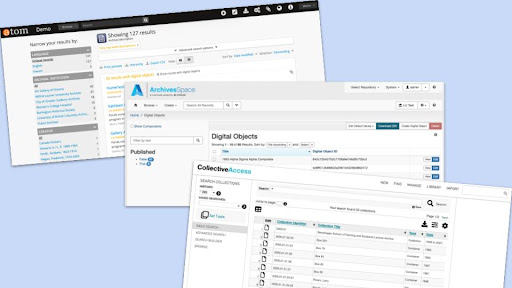In the Museum and Archives worlds, the Collection or Archive Management System used impacts everything from the day-to-day business processes of your organisation to the long-term sustainability of your records. Given its importance, it can seem overwhelming when looking into your options when planning to establish a system or change from an existing one. However, there are options, and here we have broken down some of our favourite open-source solutions.
Many of our blogs on open source software focus on spatial tools and the hard sciences. What we haven’t delved into recently is the importance of open source software in the GLAM sector (Galleries, Libraries, Archives and Museums). Ten years ago, Piers wrote a blog about open source collection management and it’s time for an update. Today we will focus on the growth of these solutions, our continuing support of them (and of that sector), and the open source projects we’ve been putting in place recently in GLAM organisations.
First, to recap, open source software means that the source code is published freely – anyone can download a copy of the code, use it, and customise it. There is also the benefit of reduced ongoing costs – rather than continuing to pay annual licensing fees, open source software installations require only hosting, and upgrades to the code. In addition to financial sustainability, open source software provides technical sustainability. Because the code is freely available, it means that the community of users can contribute bug fixes and improvements in an ongoing fashion. Realising that many GLAM organisations don’t have specialised IT departments, implementation of the software and upgrades is where Gaia Resources can assist, and we have various levels of support that can be tailored to an institution’s needs.
Open source software also supports the evidential value and provenance of your records – the source code is freely available and can be audited to ensure that your data is not being changed or manipulated by the system. Open source software provides a level of transparency for institutions that need to be able to attest that their collections are untampered with.
When working with a collecting organisation, we usually recommend one of three open source tools; Access to Memory (AtoM), CollectiveAccess, or ArchivesSpace. The solutions we provide can be out of the box – that is, it is installed as “vanilla versions” without customisation – or in some cases, they can be heavily customised such as with our Queensland State Archives implementation of ArchivesSpace. We have particular experience in implementing the Australian Series System for archives in all of these software packages.
Access to Memory is an open source tool that is developed and maintained by Artefactual (one of our partners in the current Digital Preservation project for Queensland State Archives). Artefactual also develops and maintains Archivematica – a tool for Digital Preservation. AtoM, as it is known colloquially, is a great tool for small to medium size archives. It provides not only an easy to use interface for staff, but offers an immediate web presence that allows public access to search the collections. For many of our customers, we have implemented add-ons or plugins to provide customised functionality, ranging from subscriber-only access to digital materials to online ordering.
CollectiveAccess is another popular open source collection management tool. Its flexibility is a key benefit of the software, and it can be implemented to manage collections of museum objects (including all SPECTRUM functions), archival records, and digital materials. We have implemented CollectiveAccess for several clients from across the GLAM sector, from archives to high-end art collections, and even not for profits managing their own historical collections. Whirl-i-gig, out of the United States, maintains the source code for CollectiveAccess, and our own Gaia Resources developers have contributed bug fixes and added new features to the source code as we make improvements for our clients.
ArchivesSpace is the tool that we have implemented at the greatest scale. Queensland State Archives uses a highly customised version of ArchivesSpace to manage their 64 kilometres of government records. While ArchivesSpace does come with a public interface, our work with QSA included a custom-built public interface, ArchivesSearch, and we have also implemented these systems for clients in Tasmania. Lyrasis, again in the United States, maintains ArchivesSpace core code.
With our experience over the last fifteen years, we understand the needs of collecting organisations and can recommend solutions that fit the needs and scale of the client. We stand by our passion for open source software solutions and advocate for them as the most sustainable solution for collecting institutions. Whether your organisation is small and volunteer-run or you have kilometres of records, one of the above systems can be implemented in a way to suit your needs.
Think we can help assess or even customise the best tool for your organisation? Get in touch with us via email or start a conversation with us on one of our social media platforms – Twitter, LinkedIn or Facebook.
Sarah


Comments are closed.